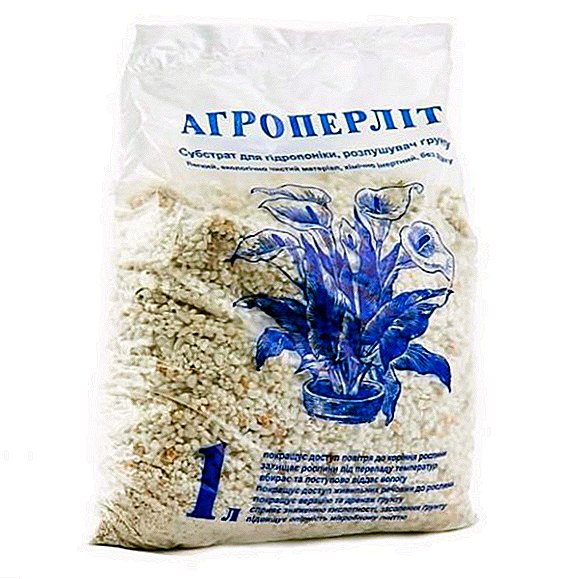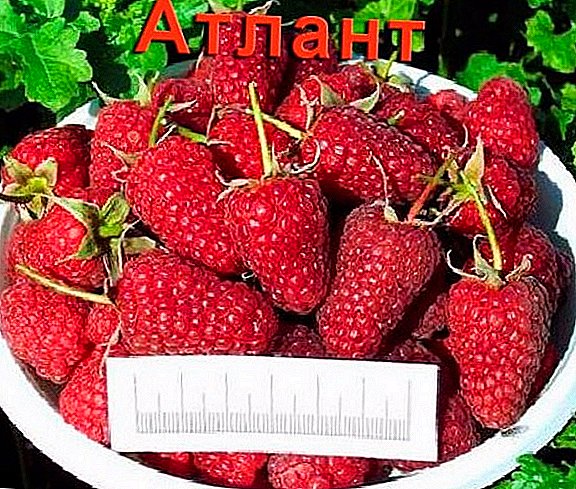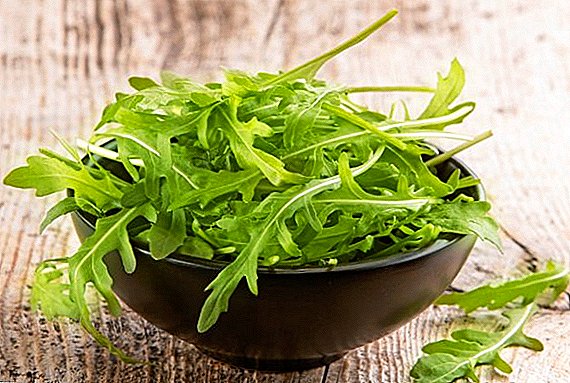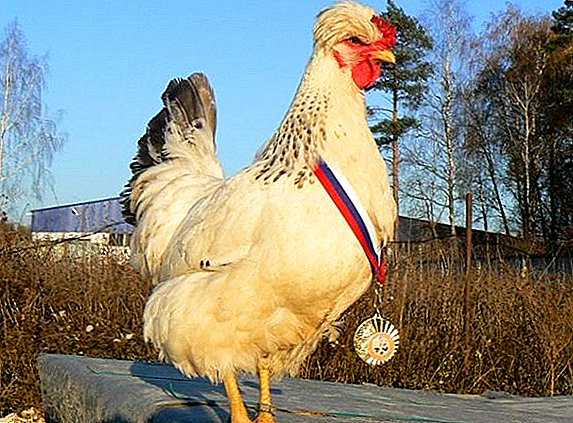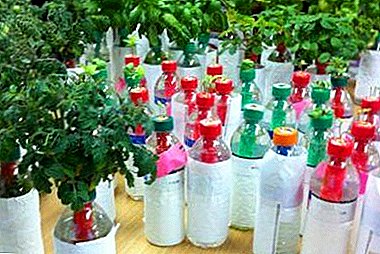
It is always a pleasure to harvest a hand-grown crop. But what if there is no land for the realization of desires?
There is a way out - growing tomatoes on a balcony in plastic bottles is an interesting and effective way to get tomato crops without leaving home and not spending large amounts of money.
The article details the method of growing tomatoes in bottles: how to plant, how to care for such seedlings, as well as what pests are dangerous. In the photo you can see this method clearly.
Is it possible to grow tomatoes in this way?
A plastic bottle is not only an economical version of the capacity for planting tomatoes, but also the most optimal one, since the material is breathable, which is very important for the root system. Also, a plastic bottle is light, so if it is necessary to move the landings from place to place, this will not be difficult.
Important! Small bottles can be used for growing seedlings, and grown seedlings replant in five liter bottles.
The disadvantages can be attributed, perhaps, only that by virtue of softness, a plastic bottle can sometimes be deformed under the pressure of the ground.
A photo
This is how tomatoes growing in plastic bottles on the balcony look like:



Preparatory activities
A place
For the cultivation of tomatoes in bottles fit balconies or loggias that overlook the south-east and south-west side. On the south side, plants can overheat and burn.To prevent this from happening, you need to organize a shading, if the balcony is located on the north side, the plants will need additional lighting for full development.
Sorta
Considering that there are not many places on the balcony, varieties with small fruits will do:
- Cherry;
- Cascade;
- Pearl Red;
- Ed.
Or any other appropriate to the stated requirement. When grown in a plastic bottle, it is better to abandon the tall varieties, preferring the undersized and dwarf, which have a compact shrub and abundant fruiting.
Capacity
The preferred bottle shape is cylindrical. This option is the easiest to fill the root system. The material of the container is plastic, but the dimensions should correspond to the size of the plant. If this is a stage of seedling cultivation, the bottles may be small; if the bush is transplanted to a permanent place, the volume of the container must be at least five liters.
Each bottle is placed one seedling.
Priming
Soil mixtures for planting tomatoes can be purchased in the finished version in stores, and you can prepare the soil yourself. To do this, you will need to mix soddy soil with humus in equal proportions, with the addition of peat and sawdust, which will improve the air permeability of the soil. At the bottom of the bottle for disembarkation it is necessary to lay out the drainage, which can be used as expanded clay.
Landing process
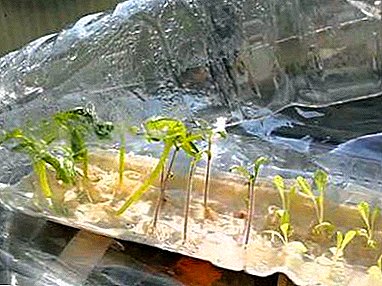 Before planting, tomato seeds are soaked in a weak solution of potassium permanganate for twenty minutes or in a solution of growth stimulant for ten hours. This will help the seeds to germinate faster and, in consequence, increase the number of seedlings.
Before planting, tomato seeds are soaked in a weak solution of potassium permanganate for twenty minutes or in a solution of growth stimulant for ten hours. This will help the seeds to germinate faster and, in consequence, increase the number of seedlings.- Seeds are shifted into the container and covered with a damp cloth.
- After two or three days, the roots will appear, after which the seeds are transplanted into bottles with ground for seedlings, deepening them to one centimeter and observing the interval of three centimeters.
- Bottles with seedlings are covered with an opaque lid and placed in heat, after the first shoots appear, the seedlings can be moved to the balcony, closer to the light. In this case, night temperatures should not be lower than + 15, and recommended daily temperatures should be +22 +25.
Step-by-step care instructions
Watering and fertilizer
Frequent watering balcony tomatoes are not required, are carried out as the earthen coma dries, since, unlike plants planted in open ground, they do not receive such a quantity of solar heat. Before the ovaries are formed and during the formation of the fruits, the soil should be kept moist, and when the tomatoes begin to ripen, the soil should not be overwetted, this will contribute to the rapid maturation.
Top dressing is better to use mineral, make according to the instructions, in any case not exceeding the dose, otherwise the plant may begin to rapidly gain green mass and not give fruit.
Trimming, pinching and pinching
The shoots that form in the leaf axils deplete tomato bushes, since all the effort goes into the formation of green mass. Pastage is performed when the shoot reaches two or three centimeters. The butchers just break off, and the place of the crush is sprinkled with wood ash or pounded activated carbon. The procedure should be carried out during the whole vegetative period.
They also cut the lower leaves so that the air beneath them does not stagnate, increasing the risk of infectious diseases.
Props and hanging
 Considering the fact that props are required mainly for tall varieties of tomatoes, and such options for growing in plastic bottles are not suitable, the organization of supporting structures can not be puzzled.
Considering the fact that props are required mainly for tall varieties of tomatoes, and such options for growing in plastic bottles are not suitable, the organization of supporting structures can not be puzzled.
Tomatoes - a plant that tends to adapt to many conditions.therefore suspension, as a result of which brushes fall out of containers with soil, is quite suitable for cultivation.
The suspended structure is made as follows.
- The two-liter plastic bottle is washed and cut off the bottom.
- The bottom is placed in the upper part of the bottle so that it is directed towards the cork.
- Next, you need to drill a hole in two parts of the bottle at once and several drainage holes in the bottom.
- Seedlings need to be removed from the container in which it grew along with the earthy clod and cover the upper part of it with a coffee filter.
- Tomato sprout gently pass through the neck of the bottle.
- Pour the mixture into the bottle, turn it over and fill it completely with earth.
- After that, insert the bottom and secure it with a wire.
- The design is ready, you can move it to the loggia and hang it in a convenient place - near the railing or on the wall.
Diseases and pests
- Blackleg - affects seedlings, root collar turns black, thinner and rot. The plant dies. To prevent the disease, watering should be moderate, and the crops are not thick. In the soil before planting, you can make Trichodermin in a mixture with Ecogel.
- Tomatoes root rot - the root neck of diseased plants rot, and they fade. The top layer of soil needs to be removed and filled in with a new one, to sanitize the soil and water the tomatoes with the “Barrier” solution.
- Gray rot - affects tomatoes in cold rainy weather. On the green or ripe fruit appear small spots, which, gradually increasing, become watery. Stems, leaves and flowers can also be covered with gray mold. Infected fruits must be removed and the air temperature raised. If the plant is severely affected, it is destroyed and the soil is disposed of.
- Fomoz - brown spots appearing on the fruits of tomato in conditions of high humidity and excess nitrogen. Internal tissues are subjected to deep rot. Affected fruit must be destroyed.
- Cracking fruit - arises from sharp fluctuations in soil moisture. The measure of control is a well-established pattern of irrigation; they should be moderate with intervals.
- Vertex Rot - occurs when there is an excess of nitrogen on the background of dryness. The solution to the problem is moderate nitrogen fertilization and regular watering.
- Spider mite - affects the plant most often in conditions of dry air, feeds on cell sap. It is possible to detect the pest on the lower part of the leaves, it also gives out its presence, covering the leaves with a thin spider web. If the damage is not strong, you can fight insects with the help of an infusion of onion peels or garlic, if significant - use insecticidal preparations.
- White fly - small insect. The lesion is manifested in the form of soot fungi. The leaves are covered with black sticky residue, dry and die. For the treatment of ailment, the plant is treated with insecticidal preparations.
Growing tomatoes on the balcony in bottles is an interesting method that does not require large expenditures and special skills. Even a novice gardener can try his hand at this lesson.


 Before planting, tomato seeds are soaked in a weak solution of potassium permanganate for twenty minutes or in a solution of growth stimulant for ten hours. This will help the seeds to germinate faster and, in consequence, increase the number of seedlings.
Before planting, tomato seeds are soaked in a weak solution of potassium permanganate for twenty minutes or in a solution of growth stimulant for ten hours. This will help the seeds to germinate faster and, in consequence, increase the number of seedlings.